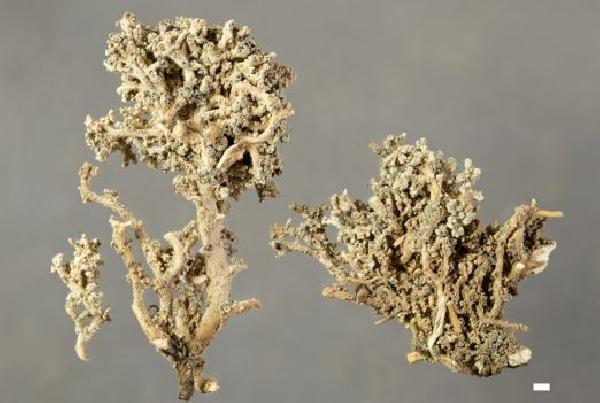Stereocaulon groenlandicum (E. Dahl) I.M. Lamb
Occ. Pap. Farlow Herb. Crypt. Bot., 5: 10, 1973.. Basionym: Stereocaulon rivulorum var. groenlandicum E. Dahl - Meddr Grønland, Biosc. 150, 2: 117, 1950.
Synonyms:
Distribution:
Description: Primary thallus crustose, ephemeral, usually absent in mature individuals, secondary thallus fruticose, forming low lax tufts. Pseudopodetia erect, sometimes appearing ± prostrate and entangled, firmly attached to the substrate, markedly rigid and woody in texture, (1.5-)2-4(-5) cm tall, 0.5-1.5(-2) mm thick, sparingly to moderately branched, with a solid cartilaginous axis of parallel hyphae surrounded by a lax medulla, the tomentum whitish to sordid bone-coloured, with occasional tinges of brown or ferruginous at base. Phyllocladia 0.2-1 mm, glaucous white with a bluish tinge, granular to slightly elongate, broader at apices, dispersed in groups along the pseudopodetia which are partly naked. Cephalodia lateral on pseudopodetia, typically pale red-brown, with a conglutinate, palisadic-radiate structure. Apothecia frequent, mostly terminal, 3-6 mm across, with a dark brown, convex disc and a thin, paler, finally excluded proper margin. Proper exciple brown in outer part, colourless within; epithecium brown, K-; hymenium colourless, 50-75 µm high; paraphyses mostly simple, c. 1.5 µm thick, the apical cells capitate, with a dark cap; hypothecium colourless. Asci (4-)8-spored, cylindrical-clavate, with a K/I+ blue outer layer and apical dome, and a central, K/I+ darker blue tube, Porpidia-type. Ascospores 3-septate, hyaline, fusiform but narrower at one end, 20-40 x 3-4 µm. Pycnidia dark, immersed. Conidia 1-celled, hyaline, cylindrical, straight or slightly curved. Main photobiont chlorococcoid. Cephalodia with Nostoc. Spot tests: K+ yellow, C-, KC-, P+ pale yellow, UV+ blue-white. Chemistry: atranorin, miriquidic acid, perlatolic acid, anziaic acid, and two unidentified substances.Note: a mainly saxicolous species also growing on mineral gravelly soil, described from Greenland and also known from Austria (Tyrol). For further details see Košuthová & al. (2024). To be looked for in the Italian Alps.
Growth form: Fruticose
Substrata: rocks, soil, terricolous mosses, and plant debris
Photobiont: green algae other than Trentepohlia (primary); cyanobacteria, filamentous (e.g. Nostoc, Scytonema) (secundary, e.g. in cephalodia)
Reproductive strategy: mainly sexual

Predictive model
Growth form: Fruticose
Substrata: rocks, soil, terricolous mosses, and plant debris
Photobiont: green algae other than Trentepohlia (primary); cyanobacteria, filamentous (e.g. Nostoc, Scytonema) (secundary, e.g. in cephalodia)
Reproductive strategy: mainly sexual

Predictive model


